Scientific name Argiope Rank Genus | Order Araneae Family Araneidae Higher classification Orb-weaver spider | |
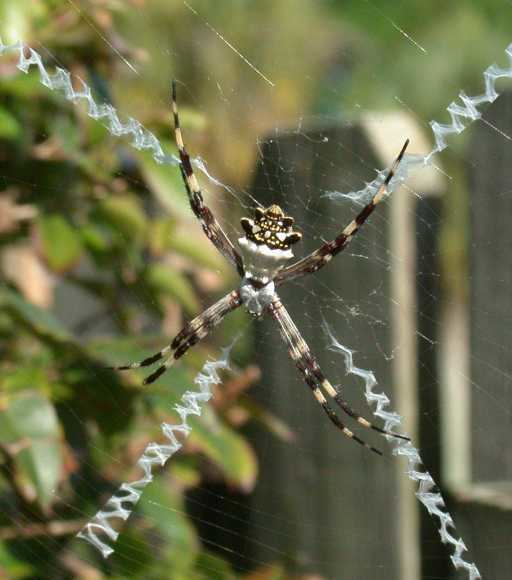 | ||
Lower classifications Argiope bruennichi, Yellow garden spider, Argiope lobata, Argiope trifasciata, Argiope argentata | ||
The genus Argiope includes rather large spiders that often have a strikingly coloured abdomen. These spiders are distributed throughout the world. Most countries in tropical or temperate climates host one or more species that are similar in appearance. The etymology of the name is from a Greek name meaning "silver-faced."
Contents
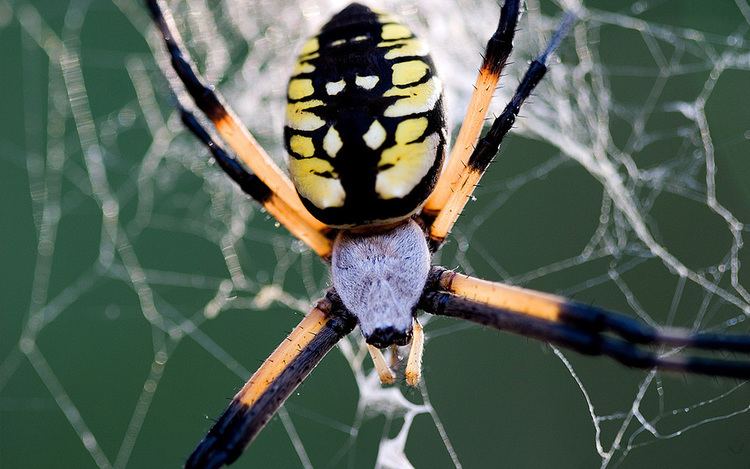
Common names

In North America, Argiope aurantia is commonly known as the black and yellow garden spider, zipper spider, corn spider, and writing spider, because of the similarity of the web stabilimenta to writing.
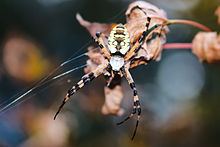
Argiope bruennichi is found only on the southern coast of England; there and in other parts of Europe, including Germany, it is known as the wasp spider. In Australia, Argiope keyserlingi and Argiope aetherea are known as St. Andrew's cross spiders, for their habit of resting in the web with legs outstretched in the shape of an X, the cross of St. Andrew. The large white zigzag in the centre of its web is called the stabilimentum or web decoration.
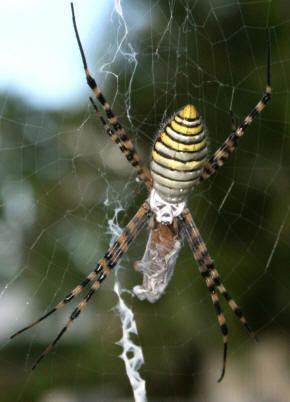
The East Asian species Argiope amoena is known in Japan as kogane-gumo. In the Philippines, they are known as gagambang ekis ("X spider", again due to the stabilementa), and gagambang pari ("priest spider", due to the spider's body resembling a priest's head with a mitre).
Web
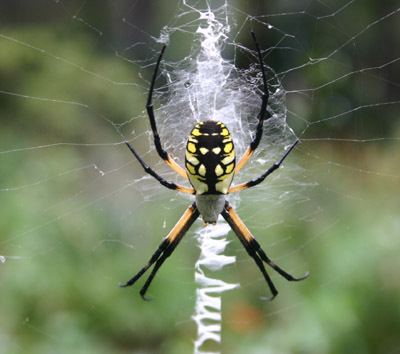
The average orb web is practically invisible, and it is easy to blunder into one and end up covered with a sticky web. The very easily visible pattern of banded silk made by Argiope is pure white, and some species make an "X" form, or a zigzag type of web (often with a hollow centre). The spider then aligns one pair of its legs with each of the four lines in the hollow "X", making a complete "X" of white lines with a very eye-catching spider coloured bright yellow on a field of black or variegated red white and yellow stripes forming its centre.
The white patterns are called stabilimentum and reflect UV light. They have been shown to play a role in attracting prey to the web, and possibly to prevent its destruction by large animals. The centres of their large webs are often just under 1 metre above the ground, so they are too low for anything much larger than a rabbit to walk under.
The overtness of the spider and its web thus has been speculated to prevent larger creatures from accidentally destroying the web and possibly crushing the spider underfoot.
Other studies suggest that the stabilimenta may actually lead predators to the spider; species such as A. keyserlingi place their web predominantly in closed, complex habitats such as among sedges.
As Argiope sit in the centre of their web during the day, they have developed several responses to predators, such as dropping off the web, retreating to the periphery of the web, or even rapidly pumping the web in bursts of up to 30 seconds, similar to the motion done by the unrelated Pholcus phalangioides.
Reproduction
The male spider is much smaller than the female, and unassumingly marked. When it is time to mate, he spins a companion web alongside the female's. After mating, the female lays her eggs, placing her egg sac into the web. The sac contains between 400 and 1400 eggs.
These eggs hatch in autumn, but the spiderlings overwinter in the sac and emerge during the spring. The egg sac is composed of multiple layers of silk and protects its contents from damage; however, many species of insects have been observed to parasitise the egg sacs.
Bite
Like almost all other spiders, Argiope are harmless to humans. As is the case with most garden spiders, they eat insects, and they are capable of consuming prey up to twice their size. A. savigny was even reported to occasionally feed on the small bat Rhynchonycteris naso.
They might bite if grabbed, but other than for defense they do not attack large animals. Their venom is not regarded as a serious medical problem for humans; it often contains a library of polyamine toxins with potential as therapeutic medicinal agents. Notable among these is the argiotoxin ArgTX-636 (A. lobata).
A bite by the black and yellow garden spider (Argiope aurantia) is comparable to a bee sting with redness and swelling. For a healthy adult, a bite is not considered an issue.
Though they are not aggressive spiders, the very young, elderly, or those with compromised immune systems should exercise caution just as one would around a beehive.
Species
As of May 2016, the World Spider Catalog accepted the following species:
